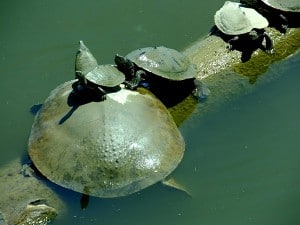Share this article
Mapping Maryland’s Reptiles and Amphibians
The only way to tell whether endemic animals are disappearing in the landscape is by keeping a close count on numbers. This isn’t even easy when trying to track giant mammals like elephants or lions in the Serengeti. But to get a grasp on the populations of every reptile and amphibian species across Maryland involves five years of concerted effort by an army of citizen scientists.
“The purpose is document the distribution of every reptile and amphibian species that occurs in the state of Maryland,” said Glenn D. Therres, one of the co-chairs of the oversight committee of the Maryland Amphibian and Reptile Atlas (MARA).

The smaller turtles in the image are false map turtles. Citizen science volunteers found the reptiles, not commonly found in Maryland, were potentially establishing a feral population in parts of the state.
Image Credit: USFWS
The goal of the five-year joint project of the Natural History Society of Maryland and Maryland Department of Natural Resources is to use a “systematic and repeatable approach” to documenting the current distributions of reptiles and amphibians across the state.
The project started in 2010 and went through to the end of 2014, using models developed from the similar breeding bird atlas projects run in the state in the early 1980s and repeated again in the early 2000s. Organizers divided the state up into a grid with 260 quads divided up into six 25-square kilometer blocks. Organizers set goals for volunteers to put in at least 25 hours of work into searching for species in individual quads. Numbers of citizen scientists that helped out varied greatly from state to state — Howard County had 200-300 volunteers while other counties had only a handful. Altogether, the project resulted in 33,000-34,000 individual sightings.
The findings could help inform policy decisions on whether some species warrant state or even federal protection, and whether other species have sufficiently recovered to be removed from listing ledgers.
For instance, citizen scientists discovered the state endangered Eastern narrow-mouthed toad (Gastrophryne carolinensis) in a wider area than formerly known to scientists. The eastern mud salamander (Pseudotriton montanus), on the other hand, only showed up in six blocks whereas historical information shows the amphibians are far more widely dispersed across coastal plains in southern Maryland.
“It appears that the eastern mud salamander must have had some population contractions,” Therres said.
Species sightings also varied greatly, and while numbers showed that this kind of overview is good for documenting expanding species and declining populations, it was difficult to pinpoint critically endangered species. Therres said the eastern hellbender (Cryptobranchus alleganiensis) — endangered in Maryland — only had one sighting, for example.
Volunteers also turned up exotic reptiles like American alligators (Alligator mississippiensis), boa constrictors (genus boa) and a Cuban tree frog (Osteopilus septentrionalis) — probably former pets or single animals that had hitched a ride northwards somehow. A green anole (Anolis carolinensis) was also found on the bumper of a car in a plant retail space on the eastern shore. These species were noted in case some population managed to take hold in the area, though nothing totally new showed up in the state with the exception of a possible feral population of false map turtles (Graptemys pseudogeographica).
While researchers will continue to evaluate the data for more possible findings in terms of declines or species recovery, according to Therres, the survey showed that amphibians in particular were more in the “coal mine” than the birds that researchers documented as part of breeding bird atlas since climate change is likely to have a bigger impact on aquatic species.
“In 100 years from now maybe we see alligators coming into southern Maryland. Or cottonmouths,” he said.
Header Image:
Citizen science volunteers made tens of thousands of reptile sightings for a project to map how populations of amphibians and reptiles were distributed across Maryland. Some species had declined, but volunteers discovered state endangered eastern narrow-mouthed toads more widely distributed than previously known.
Image Credit: Rusty Clark – Back in One Piece via flickr.








